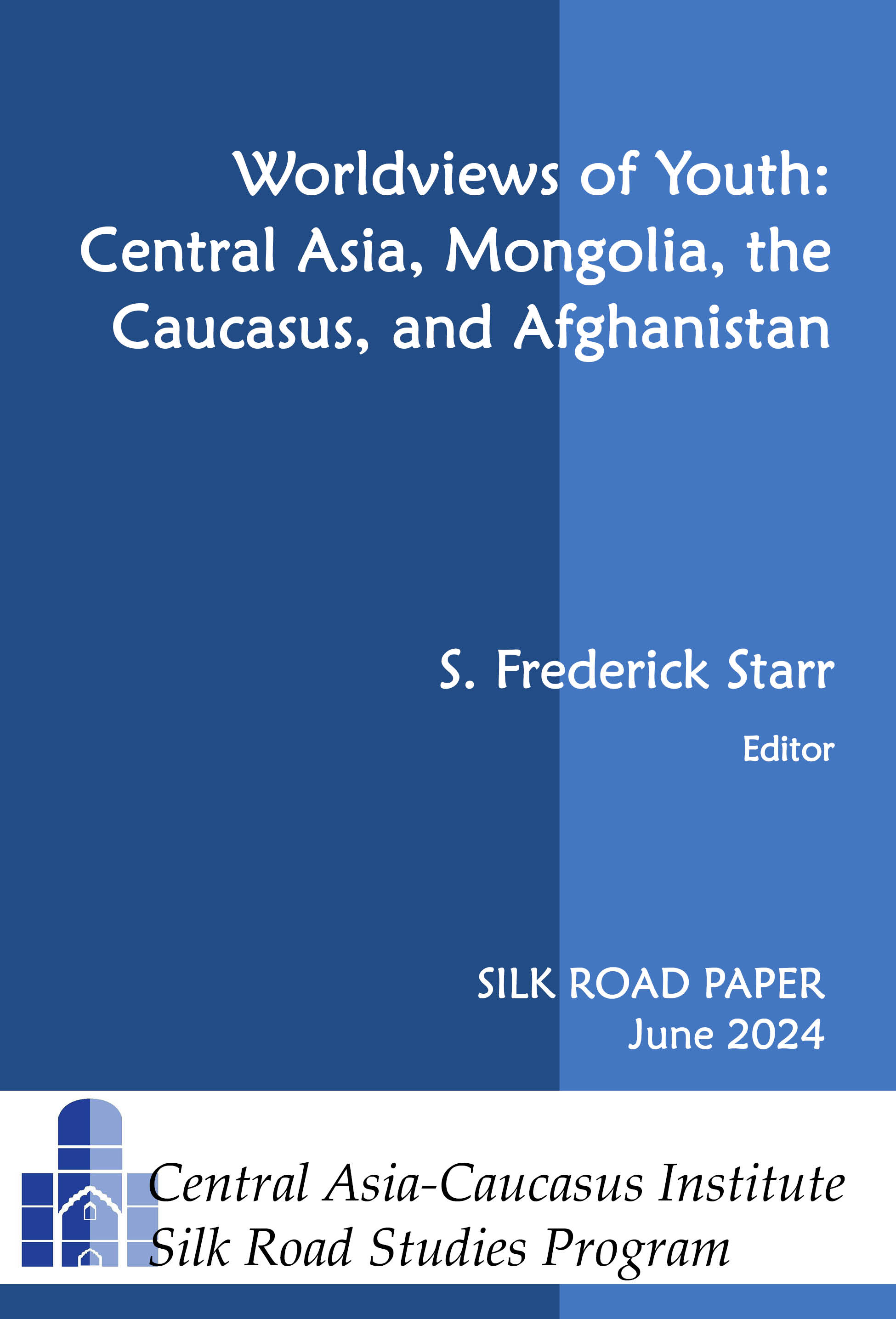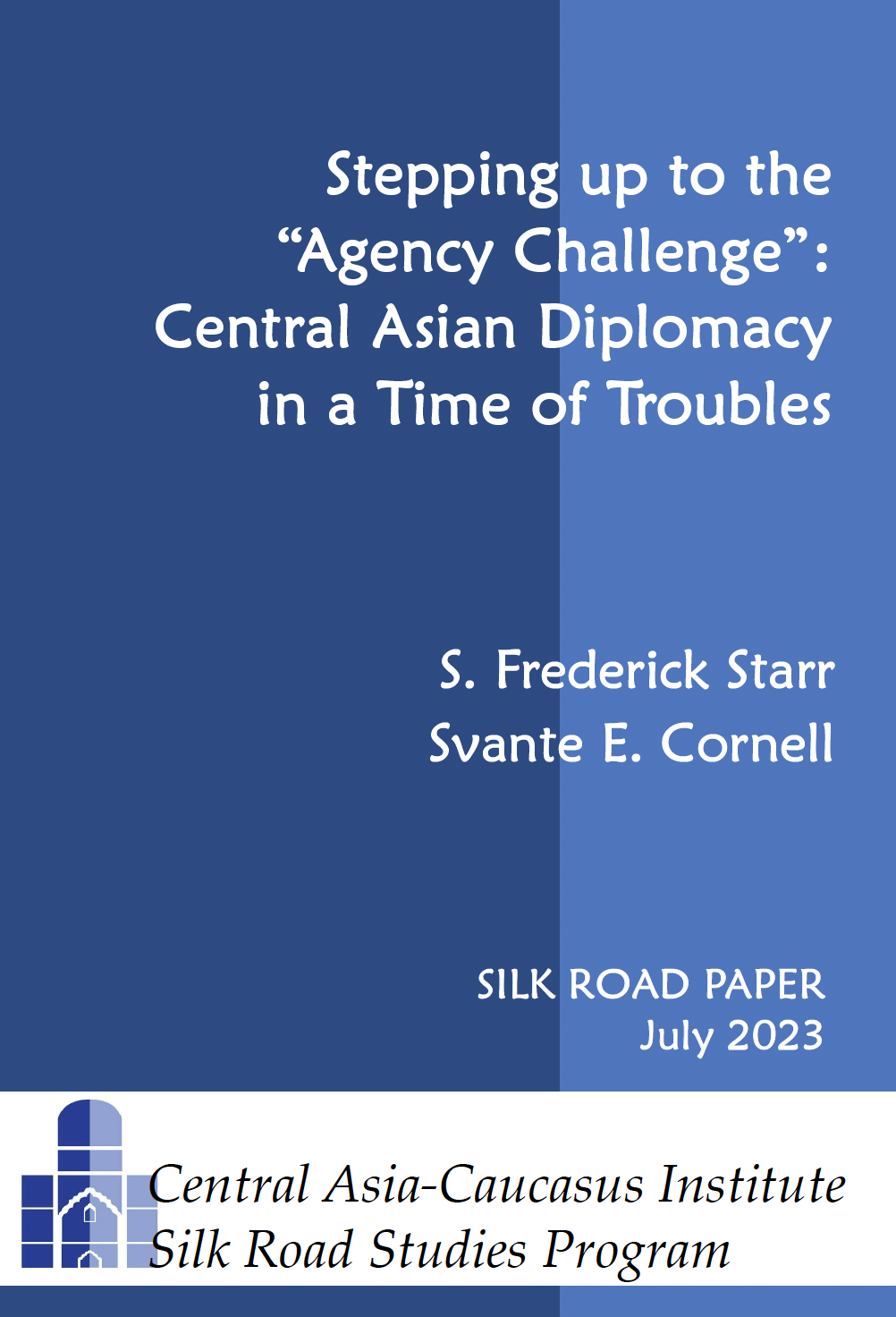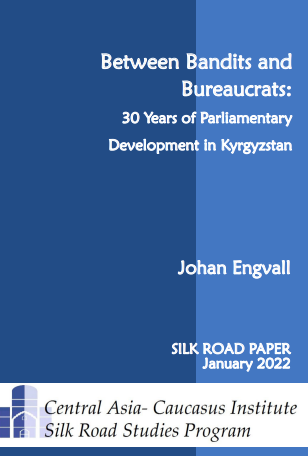Silkroad Papers and Monographs
Worldviews of Youth: Central Asia, Mongolia, the Caucasus, and Afghanistan
By S. Frederick Starr ed.
Central Asia-Caucasus Institute & Silk Road Studies Program
Silk Road Paper
June 2024
Introduction
Nearly all commentators on the evolution of the countries of Central Asia, Mongolia, the Caucasus, and Afghanistan, (i.e., the “CAMCA” countries) have concentrated on older adults and ignored younger men and women. This collection focuses instead on members of the younger generation whose outlooks have been largely neglected until now.
But what, we must ask, is a generation? For a century Europeans and Americans have coined cliches to describe each rising cohort of young people. Early on they defined their subject as young men and women in their late teens and early twenties. Now the definition commonly stretches further back into the earlier teen years. At the same time, the concept of a generation has itself changed. It was once commonly defined in biological terms, which meant a period of twenty or more years. Today –at least in the West— a social and political “generation” is often shortened to only a single decade.
Why are the views of members of the rising generation in the CAMCA countries (Central Asia, Mongolia, the Caucasus, and Afghanistan) of importance? Very simply, because their life experience differs so starkly from that of both their parents and grandparents. Their parents were raised by people born and educated in the Soviet Union or in Mongolia, under Soviet influence. In every one of these countries the current generation of parents has also been challenged by personal contact with the modern world on a global scale and by their national governments’ efforts to respond to it. As a consequence, they sit uneasily on two stools, past and present, institutional and personal, and bravely try to seek a workable balance between them. As is clear from the essays below, they do not always succeed at this. It is no exaggeration to say that parental influence on source offspring across the region has diminished.
A second and obvious issue that distinguishes the young generation in all of the countries under study is their massive access to cellphone technology and the internet. This development, which contrasts to the experience of some but not all of their elders, gives them access to world-wide “neighborhoods” of like-minded people. This constitutes second and non-institutional forms of education, which contrasts sharply with what is offered in schools, but which is very powerful nonetheless. The scale of contact with this world among members of the young generation is immense. However, it often occurs at the price of reduced communication with their more diverse physical neighbors at home. Moreover, as is clear from the reviews included in this collection, the attention of young people is also focused as much or more on music and pop culture as on the subjects that dominate traditional newspapers, radio, and TV.
All of these pressures and tensions bear directly on educational systems across the entire region and beyond. Educational reform in a post-Soviet spirit has indeed gone forward in all the countries under study, but it has been slow, tentative, and bureaucratic. Worse, to the extent it exists at all, reform has been concentrated at the university level. In some countries the rising generation has been emancipated from Soviet-type training in lower schools by the appearance of a few private institutions, but these are few in number and accessible only to the well-to-do. For the most part, younger men and women across the region are still the product of Soviet-type lower schools. While this results in high competence in mathematics and basic science, it lags in both the social sciences and humanities, leaving these fields wide open to informal learning from the internet and other non-traditional sources.
It goes without saying that the contemporary world is full of continuities that often go unnoticed. Upbringing in the family, the impact of neighbors, religion, traditional life-cycle customs, and deep-rooted musical traditions all remain much as they were in the past. Yet, acknowledging this, it is hard to imagine three generations whose life experiences differ more radically from each other than those of a typical CAMCA family over the course of recent decades.
In a first effort to map at least the outlines of the rising generation across the CAMCA region, the Central Asia-Caucasus Institute turned to its own region-wide team of experts, the 280 men and women from all ten countries who have participated in the fellowship program launched fifteen years ago by the Rumsfeld Foundation and our Institute. Now a diverse band of highly accomplished members of their societies, these leaders of business, government, the professions, and press train and hire older members of the rising generation and work closely with them on a daily basis. Many also observe the young through their own children and through their children’s friends and schoolmates.
As editors, we will resist the temptation to extract conclusions from the diverse evidence in this report or to propose implications for each of the ten societies included and for the larger region of which they are all a part. This is instead the challenge which our CAMCA contributors set before each reader. To guide such reflection, we offer the following five questions: First, is it possible to speak of this region’s rising generation as a single cohort and, if so, what are its boundary ages? Second, is it possible to speak of common generational features across the entire region, or should we focus instead on smaller groupings or even on the distinct generational identities of individual countries? Third, looking forward, what degree of discontinuity should we anticipate on a national, sub-regional, and regionwide basis? Fourth, are the CAMCA countries prepared to deal with the discontinuities and changes that the rising generation may generate? And, fifth, to what degree is the entire CAMCA region coming to participate in what French sociologist Claude Levi-Strauss called “the global monoculture”?
Experts' Scenarios on Russia's Future
By Dr. S. Frederick Starr, ed.
January 18, 2024
Experts' Scenarios on Russia's Future
 What does Russia’s future hold? Of course, we don’t know. For a century determinists of various persuasions claimed to be able to predict future developments. They believed that a very few key economic or social indicators determined humankind’s future evolution. Nowadays all but the most diehard determinists accept that a broad range of factors contribute to the direction of change. We acknowledge that along with economic and social change, factors as diverse as the values and personalities of leaders, the dynamics of groups and bureaucracies, changing sources of energy, group and national psychology, and even changes in climate can all shape the future.
What does Russia’s future hold? Of course, we don’t know. For a century determinists of various persuasions claimed to be able to predict future developments. They believed that a very few key economic or social indicators determined humankind’s future evolution. Nowadays all but the most diehard determinists accept that a broad range of factors contribute to the direction of change. We acknowledge that along with economic and social change, factors as diverse as the values and personalities of leaders, the dynamics of groups and bureaucracies, changing sources of energy, group and national psychology, and even changes in climate can all shape the future.
These and many other factors could affect the outcome of Russia’s current war on the Ukraine and developments within the Russian Republic immediately thereafter.
consensus? And if there is consensus in any area, does it acknowledge the possible importance of what Donald Rumsfeld called the “unknown unknowns”?
decade. We made a point of asking for their views on what will happen,
and not what they believe should happen. This paper presents the
thoughts of 25 respondents from 16 countries. Of course, the list could
Experts’ Scenarios on Russia’s Futures have been extended indefinitely to assure that all of the main perspectives would be represented. But ars longa, vita brevis. We are deeply grateful to
those who found time to contribute to this compendium and acknowledge
the good intentions of the many others who were not able to do so.
questions about Russia’s immediate future. Others may reject them all,
while yet others—and these are our target audience—may be so inspired
or infuriated by what they find in this collection as to lead them to pen
their own prognostications
Click here to read the full article (PDF)
S. Frederick Starr, Ph.D., is the founding chairman of the Central Asia- Caucasus Institute & Silk Road Studies Program Joint Center, and a Distinguished Fellow at the American Foreign Policy Council.
The Changing Geopolitics of Central Asia and the Caucasus

Stepping up to the “Agency Challenge”: Central Asian Diplomacy in a Time of Troubles
By S. Frederick Starr and Svante E. Cornell
Central Asia-Caucasus Institute & Silk Road Studies Program
Silk Road Paper
July 2023
Executive Summary
Central Asia is often portrayed through metaphors such as a “Grand Chessboard” or a “Great Game,” which suggest that the players in the game are the great powers, and the Central Asian states are merely pawns in this game. The problem with this analysis is that it denies agency to the Central Asian states. This might have been a plausible argument immediately upon their independence, when these states were indeed weak. But today, thirty years into independence, it is abundantly clear that the situation has changed.
Even though China, Russia, and the West are still able to influence the evolution of Central Asia in various ways, the Central Asian states are increasingly capable of defining their individual and joint interests and translating them into concrete programs. While institutionalization of their collaboration has lagged, the Taliban takeover in Afghanistan, Russia’s war in Ukraine, and other great power actions have promoted the regional governments to link arms as never before. Since 2016 this process has advanced rapidly, accompanied by more proactive strategies by the five regional governments themselves. While Kazakhstan and Uzbekistan have emerged as leaders in this process, Kyrgyzstan, Tajikistan and Turkmenistan are all engaged with this new direction, as is their neighbor across the Caspian, Azerbaijan.
It remains to be seen whether and in what ways major powers will acknowledge this development. What is already clear, however, is that “divide and conquer” policies will no longer be effective tools for dealing with the states of Central Asia, which will increasingly use their power of agency to ameliorate and shape the approaches of major powers.
The United States and Europe can take stock of this process to expand their partnership with Central Asian states. This includes expanding Western investment in the Trans-Caspian transportation corridor, while working closely with Central Asian states to prevent sanctions evasion. Western powers should also recognize the primacy of security in Central Asian realities, and support processes of reform in the defense and security sector to help Central Asians defend themselves against the encroachments of neighboring great powers. Last but not least, the U.S. should follow the example of the EU and raise the level of its interaction with Central Asia to the highest political level.
The New Secularism in the Muslim World: Religion and the State in Central Asia and Azerbaijan
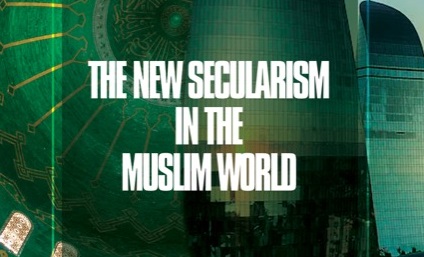
Centripetal vs Centrifugal Forces and Emergence of Middle Powers in Central Asia and the Caucasus
By Svante E. Cornell
Central Asia-Caucasus Institute & Silk Road Studies Program
Silk Road Paper
June 2023
Executive Summary
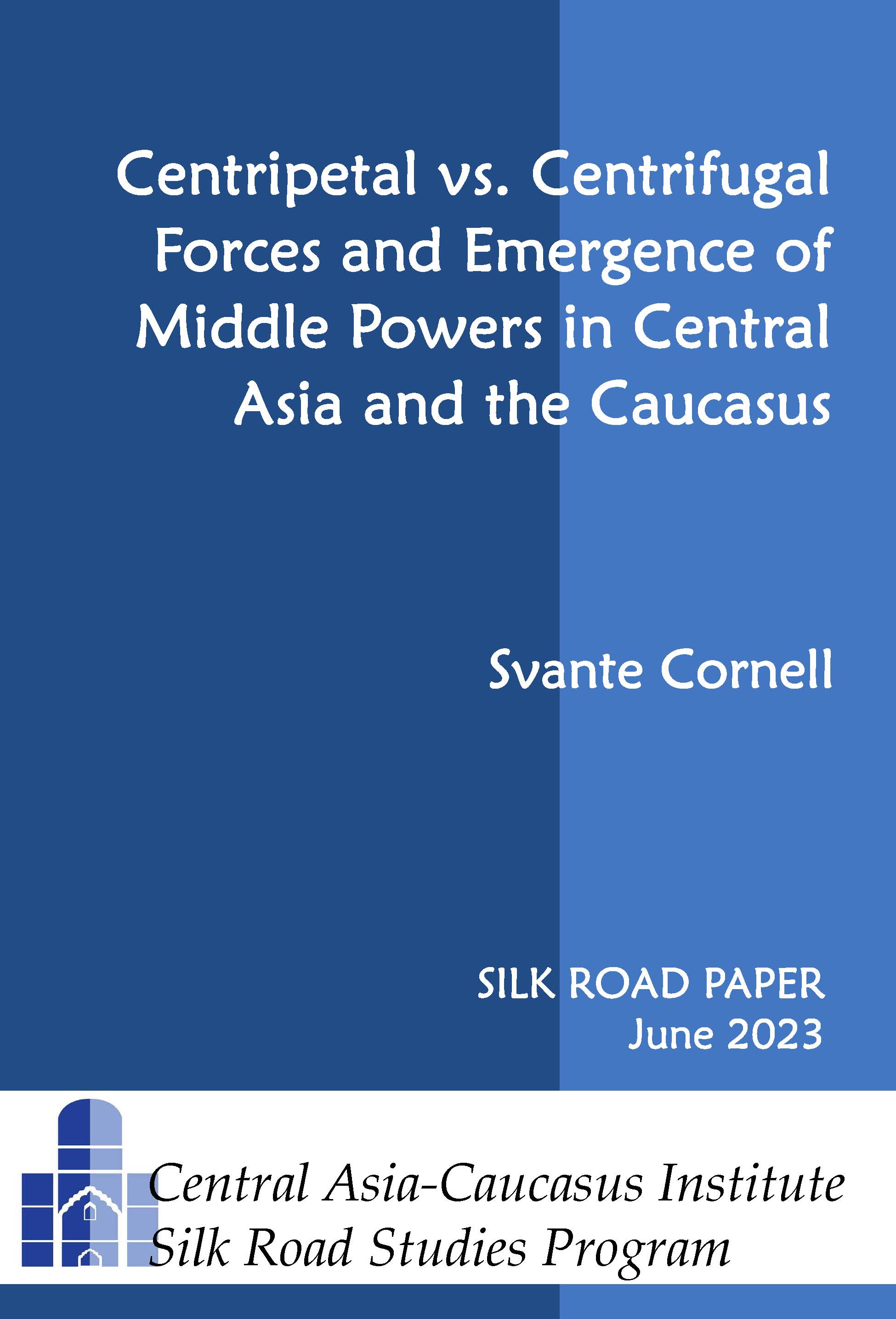 The Russian invasion of Ukraine has drawn renewed attention to the geopolitics of Central Asia and the Caucasus. These are countries that have all faced a variety of assertive or aggressive Russian measures designed to undermine their sovereignty. Their responses have varied, however, both among states and over time. This raises the question of centripetal and centrifugal forces in Central Asia and the Caucasus.
The Russian invasion of Ukraine has drawn renewed attention to the geopolitics of Central Asia and the Caucasus. These are countries that have all faced a variety of assertive or aggressive Russian measures designed to undermine their sovereignty. Their responses have varied, however, both among states and over time. This raises the question of centripetal and centrifugal forces in Central Asia and the Caucasus.
Over the past three decades, internal and external forces seeking to strengthen the sovereignty and resilience of these states have clashed with forces seeking to undermine them. This has led to a growing divergence between stronger and weaker states, as centrifugal forces have come out on top in some countries while centripetal ones have dominated in others. To wit: several states have succeeded in building the institutions of independent statehood, have embarked on efforts to reform sclerotic institutions, have gained a meaningful ability to resist the entreaties of Russia and other regional powers, and are drivers of genuine regional cooperation. Others, by contrast, have seen their statehood compromised, and find themselves in a position where they are frequently unable to resist external pressure. Some lie somewhere in between.
The development of resilience in the region is linked to the social and economic changes taking place across Central Asia and the Caucasus. Countries that were locked into the Soviet system have now opened to the influences of the world, for better and for worse. As a result, a clear divergence has emerged between the Soviet and post-Soviet generations, with the latter considerably more independent of Russian-centric information sources and thinking, and considerably less passive with regards to social and political matters.
While this social development has been largely common across the region, economic development has been vastly divergent. The region has split into oil importers and oil exporters – with the region challenging academic notions of a “resource curse.” Indeed, oil exporters have proven much more resilient against centrifugal forces than oil importers.
This is visible not least in the varying ways through which political and economic change have taken place in the region. In the mid-2000s, “color revolutions” overtook mainly the region’s weaker semi-authoritarian states, generating much hope among well-wishers of democracy in the West. But over time, it became clear that revolutionary change did not succeed in producing sustainable democratic development – either in this region or in the Middle East and North Africa following the 2011 Arab upheavals. Indeed, no country that experienced these upheavals has progressed in a sustainable way toward democracy. Even those that seemed to do so, like Georgia and Tunisia, have visibly backtracked.
By contrast, from 2015 onward another trend has emerged, whereby the leadership in stronger regional countries – Azerbaijan, Kazakhstan and Uzbekistan – have concluded that they can no longer engage in business as usual, and must answer the popular demand for change while seeking to maintain stability. As a result, they have engaged in processes of gradual political, economic and social reforms. None of these reform programs are intended primarily to liberalize the political system or transform these countries into democracies. But they contribute to shifting the logic of the state-society relations from the Soviet model, where the state dominated society, to a modern one where the state’s task is to provide services to society. In so doing, they play a significant role in strengthening the resilience of the political and economic systems.
Meanwhile, these three states have also taken a lead in the development of mechanisms of regional cooperation. In the South Caucasus, the Armenia-Azerbaijan conflict made regional cooperation impossible, and led instead to the formation of trilateral Azerbaijan-Georgia-Turkey cooperation. This began with the major oil and gas pipeline projects connecting the three states, but branched out into a formalized trilateral cooperation format with periodic meetings at the foreign minister and defense minister level, which now includes cooperation in defense industrial development and joint military exercises.
In Central Asia, efforts at regional cooperation in the late 1990s were unsuccessful, being smothered by Russian-led processes of Eurasian integration. Following the shift of power in Uzbekistan that brought Shavkat Mirziyoyev to the presidency, however, a new wind of regional cooperation has swept Central Asia. This was made possible by a greater sense of confidence in countries’ sovereignty and statehood, as well as a greater sense of political and economic urgency resulting from geopolitical competition. Simply put, regional cooperation had become a necessity to avoid great powers dividing and ruling among Central Asian states.
Five years into this new period of cooperation, Central Asian leaders are meeting more frequently than ever, and coordinating policy on various issues in a novel way. They have sought to institutionalize this cooperation, based on international examples like ASEAN and the Nordic Council. Very clearly, Kazakhstan and Uzbekistan have led this process, even going so far as to conclude a treaty on allied relations – a clear signal to outside powers that Central Asians will not be divided by them.
Finally, particularly since the geopolitical situation deteriorated following the U.S. withdrawal from Afghanistan and Russia’s assault on Ukraine, Trans-Caspian cooperation has bloomed. This began even earlier with Azerbaijan and Turkmenistan overcoming long-lasting disagreements on the development of Caspian oilfields. More recently, there has been a major expansion in Azerbaijan-Kazakhstan and Azerbaijan-Uzbekistan ties, complementing the intensification of Kazakhstan-Uzbekistan relations.
Thus, two groups of countries have crystalized in Central Asia and the Caucasus. In one group, centrifugal tendencies remain dominant, making countries weak and vulnerable to a combination of internal and external upheavals. In another, the emerging middle powers, centripetal tendencies have come to dominate, as states have developed an ability to secure their sovereignty and act to preserve it. Importantly the emerging middle powers have paid close attention to cooperation with their weaker neighbors, while also serving as a model for them.
Over the past decade, this disparity has grown clearer. Azerbaijan, Kazakhstan and Uzbekistan have all established themselves as middle powers in part through their internal development, seeking to balance the demand for change from their societies with the imperative of maintaining stability in dangerous times. Their actions on the regional scene have indicated their growing agency: by cooperating with one another and establishing relations with an assortment of foreign powers, they are strengthening their external sovereignty while also helping some of their weaker neighbors avoiding falling into dependence on great powers.
This is not to say that the weaker states totally lack resilience or that there are no vulnerabilities in the stronger ones. As evidenced by Kazakhstan’s January 2022 crisis or the unrest in Uzbekistan’s Karakalpakstan region that summer, all regional states face challenges. Still, the difference is that the emerging middle powers have taken coherent and sustained action to address the deficiencies in the provision of public services, and their leaders have spoken honestly and forcefully about the problems plaguing their government and bureaucracy. They have announced many reforms, but the hard work lies in the implementation of these initiatives, a work that is decidedly one in progress. And going forward, the risk that anti-reform forces will succeed in slowing down implementation is considerable.
The emergence of middle powers is of crucial importance for the region’s future, and for the approaches taken by foreign forces that wish the region well. In short, it means that the notion of this region as a playground of great powers is no longer valid. As the middle powers have sought to devise strategies to prevent the domination of one or another regional power over them, they have also reached out beyond the confines of the region for partners. Seeking to engage East Asian, Middle Eastern and Western powers, the middle powers of Central Asia and the Caucasus are by default partners to the West, sharing a common interest of maintaining what amounts to geopolitical pluralism in the region.
U.S. Policy in Central Asia through Central Asian Eyes
By Dr. S. Frederick Starr
May 8, 2023
U.S. Policy in Central Asia through Central Asian Eyes
"Today both the countries of Central Asia and the U.S. itself face unprecedented challenges at the global and national levels... It is important for Washington to know how its positions and actions are perceived by the countries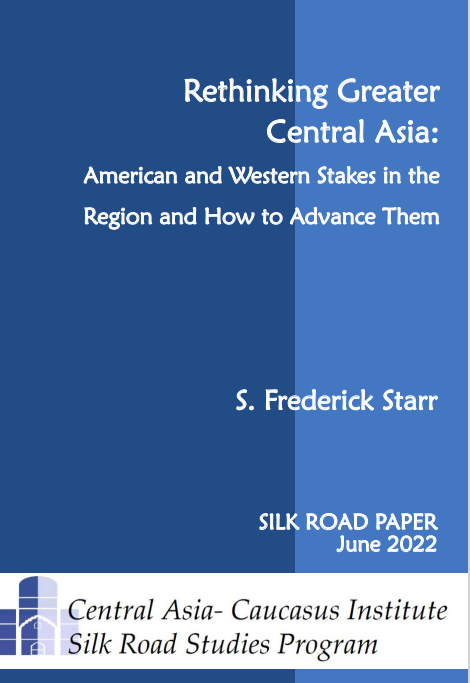 towards which they are directed. Official statements by Central Asian governments and on-the-record comments by their officials touch on this question but cannot answer it, for they often gloss over the officials’ real concerns or present them in such watered-down generalities as to render them unrecognizable. In an effort to gain a better understanding of how Central Asian governments perceive American policies we have therefore turned to the Central Asians themselves, including senior officials, diplomats, business people, local policy experts, journalists, and leaders of civil society organizations. In all, we have conducted some fifty interviews. All our subjects spoke on the condition of strict anonymity and “not for attribution.
towards which they are directed. Official statements by Central Asian governments and on-the-record comments by their officials touch on this question but cannot answer it, for they often gloss over the officials’ real concerns or present them in such watered-down generalities as to render them unrecognizable. In an effort to gain a better understanding of how Central Asian governments perceive American policies we have therefore turned to the Central Asians themselves, including senior officials, diplomats, business people, local policy experts, journalists, and leaders of civil society organizations. In all, we have conducted some fifty interviews. All our subjects spoke on the condition of strict anonymity and “not for attribution.
Click here to read the full article (PDF)
S. Frederick Starr, Ph.D., is the founding chairman of the Central Asia- Caucasus Institute & Silk Road Studies Program Joint Center, and a Distinguished Fellow at the American Foreign Policy Council.
Constitutional Reform in Uzbekistan: A Symposium
Svante E. Cornell, ed.
Central Asia-Caucasus Institute & Silk Road Studies Program
Silk Road Paper
December 2022
Click to Download PDF
Buy on Amazon
Introduction
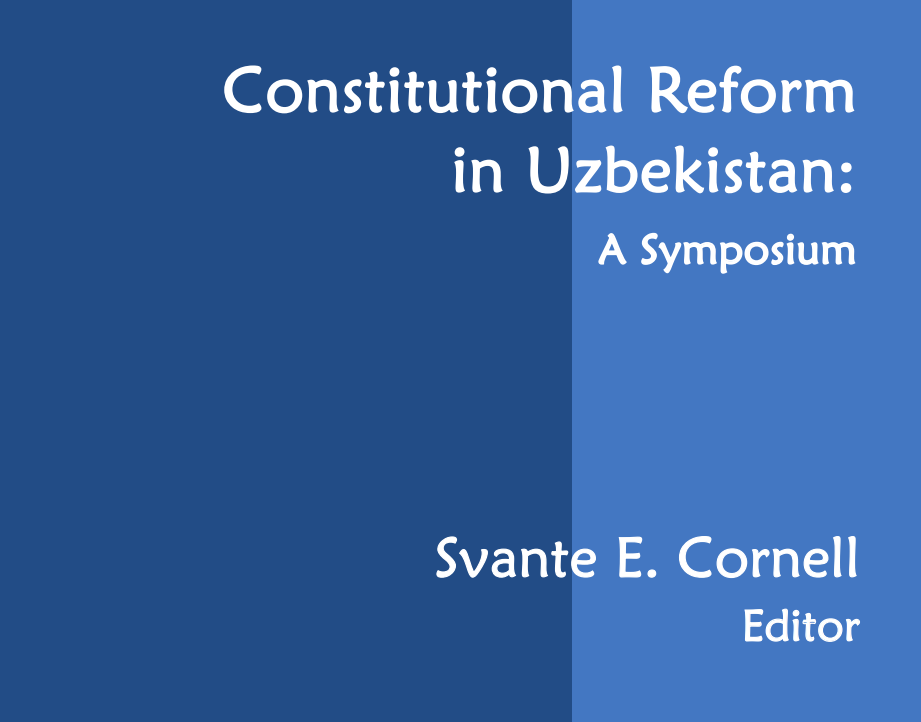 How does political change happen? This question, which has occupied the minds of scholars and analysts for many decades, has been especially vexing for the broad lands that include the Middle East and Central Asia. Samuel P. Huntington identified a “third wave” of democratization between the mid-1970s and 1990, and the collapse of the Soviet Union appeared to confirm that democracy would now spread unhindered across the world. But in the Middle East and Central Asia, this did not happen. Quite to the contrary, in spite of some liberalizing efforts in the 1990s, what occurred in this region was more akin to what Huntington, who passed away in 2008, would have called a “reverse wave” – with authoritarian governments proving not only resilient but able to consolidate control over societies.
How does political change happen? This question, which has occupied the minds of scholars and analysts for many decades, has been especially vexing for the broad lands that include the Middle East and Central Asia. Samuel P. Huntington identified a “third wave” of democratization between the mid-1970s and 1990, and the collapse of the Soviet Union appeared to confirm that democracy would now spread unhindered across the world. But in the Middle East and Central Asia, this did not happen. Quite to the contrary, in spite of some liberalizing efforts in the 1990s, what occurred in this region was more akin to what Huntington, who passed away in 2008, would have called a “reverse wave” – with authoritarian governments proving not only resilient but able to consolidate control over societies.
The political stagnation of the broader region led to considerable frustration among foreign well-wishers of these regions – and more importantly, among large strata of people in these regions that experienced heavy-handed government, mismanagement, and systematic corruption. Between 2003 and 2011, popular revolts overthrew a series of governments – first in the post-Soviet space, particularly Georgia and Ukraine, and subsequently in the Middle East and North Africa. These upheavals were met with great enthusiasm in western circles, who were convinced that democracy had finally come to the Middle East and North Africa.
Except it did not work out that way. The “Color Revolutions” in the former Soviet Union and the Arab upheavals largely failed, as no country that experienced these upheavals has progressed in a sustainable way toward democracy. Most are worse off than before these upheavals. Libya, Syria and Yemen have descended into civil war. Georgia and Ukraine were invaded by Russia, in part because of their political changes, and Kyrgyzstan descended into instability, with two additional upheavals as well as ethnic rioting. Egypt almost saw state capture by the Muslim Brotherhood, which was only undone through a military intervention that proved lasting. For some time, Georgia and Tunisia appeared to go against the grain, and make sustained progress – but in recent years, those two have backtracked significantly. While many of these societies underwent change that increased the level of pluralism in the political system, mostly they did not succeed in addressing underlying causes of public frustration, such as mismanagement and corruption. All in all, it seems clear that revolution did not prove a sustainable model to liberalize societies.
In the past several years, however, an alternative model of political change has been on display in the region – an evolutionary model of political development. Following the political and economic upheavals of the past decade, the leadership in some countries appear to have concluded that “business as usual” is no longer feasible; they must answer to popular demands for change, while seeking to manage the political process to maintain stability and avoid upheavals. As a result, they have implemented reforms from the top down, seeking to improve the efficiency of government and in a controlled and gradual manner expand political rights. This is happening in countries as diverse as Azerbaijan and Jordan, Kazakhstan and Morocco. But Uzbekistan plays a particular role because of the sheer rate of change in the country.
Nowhere is the contrast between the “before” and the “after” as dramatic as in Uzbekistan following the accession to power of President Shavkat Mirziyoyev. While paying respects to his predecessor Islam Karimov, Mirziyoyev departed dramatically from Karimov’s approach to both foreign and domestic policy, unleashing a torrent of reform initiatives that have changed Uzbek society for the better.
Of course, it should be understood that the evolutionary process of reform will not turn Uzbekistan, or any other country engaging in it, into a model democracy in the short term. That is not the purpose of these reforms. That does not mean these reforms are “cosmetic,” as they are frequently called: they are highly ambitious in scope, because they aim to fundamentally change the relationship between state and society. It should be recalled that in the Soviet system, the individual was subordinated to the all-powerful state. This in turn bred impunity and corruption, as documented already in 1982 by Soviet exile Konstantin Simis in his book USSR: the Corrupt Society. This Soviet legacy is one that in some ways continues to this day – but is one that reformist leaders like President Mirziyoyev are now trying to reckon with. In the place of the old logic, they are seeking to turn the tables, and turn state institutions into bodies that exist to serve the citizens of the country rather than to control them or extract rents from them.
This is the background to the constitutional reform process in Uzbekistan, launched in the summer of 2022. As such, it is not an isolated event, but very much a step in the process of reforms that have been introduced since President Mirziyoyev acceded to the presidency in 2016.
This process is one that the Central Asia-Caucasus Institute & Silk Road Studies Program documented in several entries in the Silk Road Papers series, and in the 2018 book, Uzbekistan’s New Face. This time, the Joint Center was pleased to have the opportunity to cooperate with the Center for Development Strategy in Tashkent to organize a Symposium on the constitutional reform process. This event, held in July 2022, provided an opportunity for Western and Uzbek researchers to exchange views on the reforms process. This publication is a collection of their presentations.
We are grateful to the authors of these papers and to the Center for Development Strategy, and particular its Director Eldor Tulyakov, for the opportunity to bring these papers to print.
Social Reforms in Kazakhstan
By Albert Barro and Svante E. Cornell
Central Asia-Caucasus Institute & Silk Road Studies Program
Silk Road Paper
September 2022
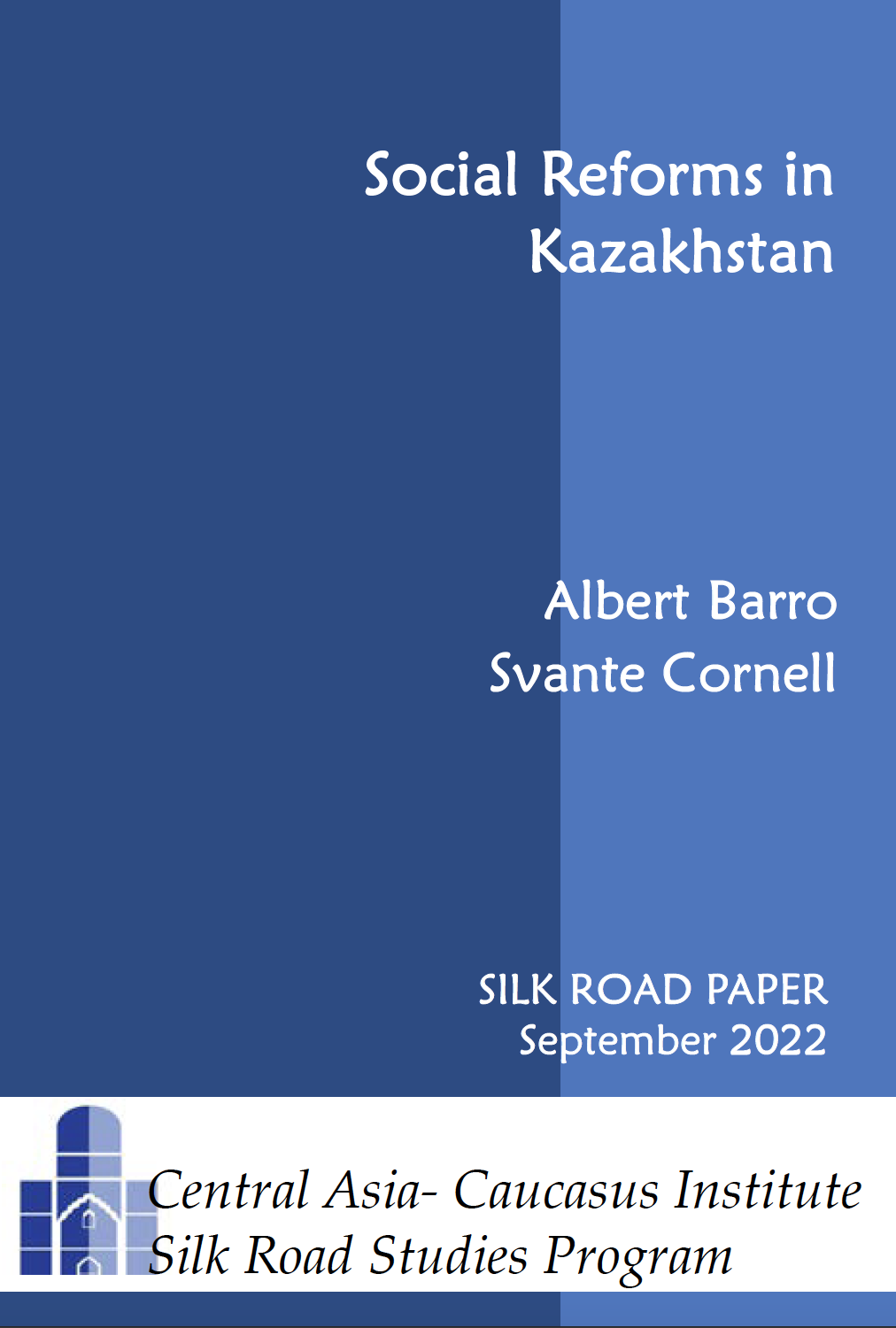 Since President Kassym-Jomart Tokayev came to power, a series of reform packages focusing mainly on the political and economic sectors have been launched in Kazakhstan. But as has been seen in instances of public dissatisfaction over recent years, social issues are at the heart of the concerns of the population of Kazakhstan – a population that saw great improvements in living standards from 1992-2008, but somewhat of a stagnation since then. Having achieved middle-income status, many people in Kazakhstan now focus increasingly on the quality and accessibility of education, healthcare, and social protection. In his September 1, 2022, address to the nation, President Tokayev acknowledged this priority by focusing considerable attention to reforms in the social sector that would improve education, healthcare and social protection and in particular provide a more equitable delivery of services in these areas to the population.
Since President Kassym-Jomart Tokayev came to power, a series of reform packages focusing mainly on the political and economic sectors have been launched in Kazakhstan. But as has been seen in instances of public dissatisfaction over recent years, social issues are at the heart of the concerns of the population of Kazakhstan – a population that saw great improvements in living standards from 1992-2008, but somewhat of a stagnation since then. Having achieved middle-income status, many people in Kazakhstan now focus increasingly on the quality and accessibility of education, healthcare, and social protection. In his September 1, 2022, address to the nation, President Tokayev acknowledged this priority by focusing considerable attention to reforms in the social sector that would improve education, healthcare and social protection and in particular provide a more equitable delivery of services in these areas to the population.
In the education sector, Kazakhstan has a history of large and comparatively successful reforms. The Bolashak (future) program, launched almost immediately following independence, provided opportunities for high-achieving students to study abroad, and over ten thousand have done so. But Kazakhstan’s reforms have not focused solely on higher education. One of the most successful programs has seen the rollout of nearly universally available preschool education, and efforts to improve the status, pay, and training of teachers in primary and secondary education. Kazakhstan joined the Bologna process, and the implementation of nternational standards has done a lot to improve the education system.
Kazakhstan also invested in elite institutions – the Nazarbayev Intellectual Schools and Nazarbayev University, which have catered to high-achieving students. These institutions have obtained ample resources and have been highly successful – NIS scores in PISA tests, for example, are high above the average in OECD countries. Kazakhstan’s difficulty has been to replicate this success across the width of the education system. Access to education in rural and remote areas remains difficult. And whereas NIS and NU have benefited from academic and financial autonomy, the same is not the case for regular schools, whose principals have much less freedom to run their institutions the way they see fit. In other words, the rest of the public school systems suffers from state bureaucracy. And regular schools – particularly in rural and remote areas – lag far behind the NIS in standardized testing. This should come as no surprise given the disproportional part of the education budget that is allocated to the NIS and NU.
The question going forward is to what degree the NIS and NU model can be replicated in the rest of the education system – which does not benefit from having selected the best students and given them the most resources.
Human resources are a particular challenge: finding qualified teachers for the needs of Kazakhstan has proven difficult, and is made even harder by the government ambition to develop trilingualism: that not only should
Kazakh, Russian and English be taught, but that certain subject matters should be taught in these languages. While the initiative is laudable, in practice the country so far lacks teachers with language skills to be able to
teach in all three languages. This suggests that some initiatives in the education sector may have been overly ambitious; but it should be recalled that Kazakhstan has aimed high; and even if it has not quite met its own
ambitions, the initiative has nevertheless produced results as can be seen from the rapid spread of English proficiency in the country.
Healthcare reforms in Kazakhstan are in many ways similar to the education sector. Certain reforms have aimed very high and proven remarkably successful. Capabilities at the high end have been developed, including a medical school at Nazarbayev University, advanced cancer treatment and research, and the development of an indigenous pharmaceutical industry. In addition, Kazakhstan has rolled out a compulsory health insurance system that is sustainable in the long run. Just as in the education sector, however, the difficulty has been in scaling these advances up to meet the needs of society as a whole. One challenge has been to provide adequate primary healthcare services that run independently of major hospital systems. Another has been to train enough medical staff to provide adequate coverage of the population. Indeed, Kazakhstan needs to double the ratio of doctors per capita to meet the OECD average. In particular, providing adequate access to medical services in rural and remote areas has proven difficult to implement.
Still, the advances are visible. Before the pandemic, Kazakhstan saw rapidly improving life expectancy numbers, reaching 73 years, a strong improvement over numbers in the 1990s. While the pandemic was a temporary setback, the country has also learnt valuable lessons on the weaknesses of its healthcare system.
In the field of social protection, Kazakhstan has succeeded in putting in place an adequate system to protect the unemployed, the disabled, as well as mothers and children. In addition, a strong and sustainable pension system has been introduced. Still, the country faces challenges: an aging population that will complicate matters, and the continued persistence of high-level corruption and mismanagement of assets and investments.
Social reforms are intimately linked with the broader reform agenda that President Tokayev has made into a centerpiece of his presidency. The success of social reforms will depend in no small part on the development of the broader management system in the country and on the nature of Kazakhstan’s state institutions. The potential of social reforms can only be fulfilled if the political reforms aiming to change the nature and culture of state institutions, to develop a new reality where the state exists not for its own sake, but to provide services to the population of the country. Given President Tokayev’s stated commitment to seeing all of these reforms through, it remains to be seen how successful Kazakhstan will be along this path.
Rethinking Greater Central Asia: American and Western Stakes in the Region and How to Advance Them
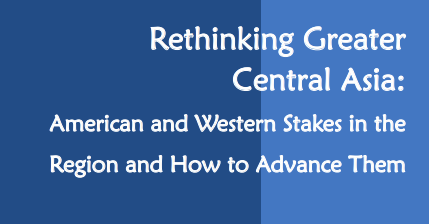
Between Bandits and Bureaucrats: 30 Years of Parliamentary Development in Kyrgyzstan
Central Asia-Caucasus Institute & Silk Road Studies Program
Silk Road Paper
January 2022
In 2010, Kyrgyzstan took a decisive step towards establishing a parliamentary form of government. A decade later, the parliamentary experiment had, at least for the time being, come to an end; in January 2021, the Kyrgyz electorate approved the return to a presidential form of government, and in May 2021, a new presidentialist constitution was adopted. To understand, the role and powers of Kyrgyzstan’s parliament, unparalleled in the Central Asian region as well as in most other post-Soviet countries, this study details the evolution of this particular political institution over the past 30 years. It details continuities and changes, the interplay between formal rules and actual parliamentary practices, and analyses how the constitution of this political body has shaped its performance over the years. The conclusions reached in the study should help to inform the understanding of why Kyrgyzstan’s national legislature proved unable to deliver on the promises of a parliamentary-style system of government.
Independence in 1991 meant that Kyrgyzstan’s Soviet-elected 350-member strong Supreme Soviet overnight became the national parliament of a sovereign state. It became clear that the legislature did not take this newfound status lightly. It quickly emerged as a focal point of debates over the future course of the new state, often positioning itself in opposition to the country’s first President Askar Akaev. Its willingness to provide some checks and balances on executive authority as well as its adoption of several landmark laws, would lead the parliament to go down in Kyrgyzstan’s history as the “legendary” parliament. However, it was also a peculiar institution, created for the altogether different Soviet system. It met only in sessions, and the lack of continuous legislative work was hardly compatible to the systemic transformation that Kyrgyzstan had set out to accomplish. Many of its members simultaneously held positions in various executive bodies. Because of that, the separation of powers was unclear and the fact that a large portion of the members of parliament (MPs) was dependent on other state jobs for their livelihoods, enabled President Akaev to disband its services a year before its term had expired.
In 1995, Kyrgyzstan held its first competitive elections to fill a thoroughly revamped parliament that now had adopted its Kyrgyz name, Jogorku Kenesh (Supreme Council). It was a much smaller legislature, consisting of two chambers with a total number of 105 MPs elected in single mandate districts. This formative election turned out to be highly competitive and resulted in a legislature dominated by public officials and an emerging group of businessmen, who had benefited from the early privatization process. In this new competitive environment, many members of the “legendary” parliament failed to be re-elected. While the new parliament had to find its feet amidst organizational shortcomings and Soviet inertia, it nevertheless managed to promulgate an impressive number of new laws, although many pieces of legislation were hastily adopted and poorly implemented. Overall, the parliament retained a rather independent position and did not turn out to be as obedient to the executive as President Akaev had hoped for it to be.
The successor parliament with curtailed formal powers, following constitutional referendums in 1996 and 1998, respectively, was elected in 2000; again, the elections were competitive, but circumscribed by several fraudulent practices and an aggressive use of administrative resources in order to secure the outcome preferred by the authorities. A limited party quota had been introduced for some of the seats, but overall businessmen and bureaucrats from the central and regional levels continued to define the parliament’s composition. The parliament appeared pliant to begin with, but several controversial decisions taken by President Akaev forced an increasingly radical parliamentary opposition to emerge. Conventional parliamentary opposition did not characterize their oppositional activities as much as the practice of organizing mass protests.
Ahead of the 2005 parliamentary elections, constitutional changes pushed through a referendum ended Kyrgyzstan’s decade with a bicameral parliament. A new unicameral legislature, with a significantly reduced number of seats for grabs exclusively in single mandate districts, raised the stakes further for electoral competition. At a time when President Akaev’s popularity had long been in decline, the authorities nevertheless applied their best efforts to secure the desired electoral outcome. Losing candidates challenged the election results by organizing protests throughout the country, eventually building up to nationwide opposition movement against the incumbent leadership. When the protests reached the capital Bishkek, President Akaev fled the country. Following this first color revolution in Central Asia, new president Kurmanbek Bakiev confronted a couple of years of strong parliamentary opposition, which thwarted his attempts to establish authoritarian rule in the country. Eventually, in 2007, after two years of recurring mass protests on the streets of Bishkek led by the parliamentary opposition, Bakiev managed to co-opt the sufficient amount of MPs necessary to push through a new presidentialist constitution. He then dissolved the parliament and announced a snap election to bring the legislature in line with the new constitution.
The snap parliamentary vote brought about a legislature that was entirely new in its form. It was exclusively elected on the basis of proportional representation from nationwide party lists. Bakiev and his entourage ensured their control of the new legislature by quickly and effectively organizing a pro-presidential party, Ak Jol, which duly emerged victorious with 71 of 90 available seats. With this parliament in their pocket, the president and his family members fully displayed their repressiveness. However, when growing frustrations among the elites and people canalized into sudden protests, the Bakiev regime quickly collapsed, despite its efforts to suppress the revolt. The new interim leadership quickly dissolved the parliament and cancelled the constitution.
Ahead of the election of a new parliament, the interim government introduced a new constitution, which stood out in the post-Soviet context; for the first time since Moldova in 2000, a post-Soviet country declared its ambition to establish a parliamentary-style system of government. The electoral system retained the proportional system based on national party lists introduced by Bakiev, but to prevent the emergence of a dominant party, the maximum number of seats a party could hold was fixed at 65 out of 120 seats. The assumption being that this would prevent Kyrgyzstan from slipping back towards authoritarianism. From a competitive point of view, the election was a success: it brought five evenly matched parties into the parliament, demonstrating the realness of political competition. For the first years, the parliament well and truly emerged as the focal point of political decision-making and debate in the country. Nonetheless, the parties were typically only formal shells with little real party content, and therefore most of them disintegrated from within. The coalition governments formed around parliamentary majorities fell apart in quick succession, leaving the role of the prime minister in this divided executive system increasingly subordinated to the president. In this environment, President Almazbek Atambaev did not have to resort to particularly repressive means in order to re-establish the presidency as the focal point of the political system.
This tendency strengthened further after the election of a new legislature according to the same basic rules in 2015. It has served during the tenure of three different presidents, with the main distinguishing feature being its unconditional support for the various heads of states’ taking the country in an ever more authoritarian direction. Thus, the last parliament represents a litany of failures: it has failed to serve as a safeguard against presidential authoritarianism, it has failed to contribute any significant reform legislation and it has failed to strengthen the development of political parties.
Over the course of the past three decades, Jogorku Kenesh’s development has been a process of trial-and-error; progressive elements interact with regressive elements in defining the entire spectrum of parliamentary practices – from campaigning to composition and performance. The search for the parliament’s rightful place in Kyrgyzstan’s political system has been at the heart of much political debate and numerous constitutional and electoral changes. The recurrent changes in the formal rules of the game have forced political elites to adapt their behavioral strategies to a fluctuating environment. Despite the introduction of special quotas and the efforts to foster the rise of political party representatives based on ideological interests, the typical MP consists of a 50-year-old Kyrgyz man with a strong provincial attachment and a primary background in various business activities for whom party affiliation is an exchangeable political commodity.
This leads us to the peculiar role of political parties in Kyrgyzstan’s political system. The party market in Kyrgyzstan is richly supplied, and a defining feature has been the inability of presidents to create viable ruling parties, unlike in other Eurasian countries. However, Kyrgyzstan’s party system is extremely fragmented and weakly institutionalized; parties primarily, serve as temporary vehicles for particular political interests, not as channels for political representation. Their ideological platforms are underdeveloped with little in terms of concrete policy programs. Instead, they increasingly tend to position themselves by emphasizing lofty values related to cultural and nationalistic specifics of the Kyrgyz nation. In practice, the party system placed at the center of the parliamentary-style system boiled down to little more than a political label required in order to compete in election, but had little meaning otherwise.
The parliament in general and political parties in particular have been subjugated to a powerful market logic. Financial muscles have been key to securing access to parliament. Under proportional representation based on party lists, parties put a price on their slots, turning parliamentary mandates into subjects of an internal market. As candidates entered the parliament against the backdrop of large financial contributions, reportedly often amounting to several hundreds of thousands of dollars, they have had strong incentives to return their investments. Consequently, the parliament has emerged as a marketplace for transacting corrupt deals.
Overall, Kyrgyzstan’s parliament has played a dynamic role in the country’s political development. In some periods, it has been at the heart of the political struggle and provided some checks and balances, if erratic, on presidential authority. In other periods, it has served as a more pliant rubberstamp body. Over time, the technical, procedural and organizational framework for parliamentary work has steadily improved. At the same time, the corps of parliamentarians have become ever more primitive in its composition. While the “legendary” parliament represented the political, economic and intellectual elite of Kyrgyzstan, the last parliamentary convocations, defined by financial resources, have dissolved any remaining boundaries for the qualities needed for being entrusted with a parliamentary mandate. As a result, a group of “entrepreneurs,” including oligarchs, racketeers, bazaar owners, construction magnates and civil servants with concealed business interests, has established a strong grip over parliament, to the detriment of the supply of nationwide legislation and the establishment of mechanisms of accountability to the electorate.
Finally, in a comparative perspective, Kyrgyzstan’s disappointing “parliamentary decade” from 2010 to 2020, mirrors the governance crises that have beset the other post-Soviet states attempting to establish a parliamentary system of government – Armenia, Georgia and Moldova. These challenging experiences underlines the complexity of democratization in states suffering from immature state institutions and low levels of economic development. It also reveals that, in such contexts, increased political competition is by no means likely to lead to improved governance, in terms of delivering state services and the adoption of sustainable economic development. This suggests the somewhat disheartening conclusion that the state must first get its core functions in place, such as the provision of elementary law and order and basic economic and social security, before a truly viable form of government characterized by meaningful political competition is likely to take hold. In short, a separation should be made between the normative aspects of democratization, i.e. the inherent virtues of pluralism, freedom and competitiveness, and the empirical relationship between on the one hand democratization and the quality of government, corruption and economic development, on the other.
